AI Research
AI use in colonoscopies may erode doctors’ tumor detection skills, study finds

A new study published in The Lancet Gastroenterology & Hepatology found that routine use of AI-assisted colonoscopy systems may lead to a roughly 20% drop in experienced gastroenterologists’ ability to detect adenomas — precancerous growths in the colon — when performing the procedure without AI.
The research was conducted at four colonoscopy centers in Poland between September 2021 and March 2022 as part of the ACCEPT project (Artificial Intelligence in Colonoscopy for Cancer Prevention). In late 2021, the centers began routine use of AI systems to detect polyps, after which colonoscopies were randomly assigned to be performed with or without AI assistance.
In total, 1,443 colonoscopies without AI were analyzed: 795 before AI’s introduction and 648 after. All were conducted by 19 experienced physicians, each with more than 2,000 procedures performed. The adenoma detection rate in non-AI exams fell from 28.4% (226 out of 795) before regular AI exposure to 22.4% (145 out of 648) afterward — a 20% relative decrease and an absolute drop of 6 percentage points. By comparison, AI-assisted colonoscopies during the same period had a 25.3% detection rate (186 out of 734).
“Our findings are concerning given the rapid spread of AI in medicine,” said Dr. Marcin Romanczyk of the Medical University of Silesia in Poland. He called for more studies on how AI affects professional skills across medical specialties to address potential unintended consequences.
Colonoscopy is one of the most effective tools for preventing colorectal cancer, allowing doctors to detect and remove adenomas before they turn malignant. AI-assisted systems have been met with enthusiasm in recent years, with several studies showing higher detection rates when they are used. But the new findings raise concerns over “skill erosion” — the gradual loss of expertise when physicians rely too heavily on such support.
The study also questions prior randomized controlled trials that found AI-assisted colonoscopy outperformed non-AI procedures. “It is possible that non-AI colonoscopy in those trials was different from standard non-AI colonoscopy, because physicians might have been negatively influenced by ongoing AI exposure,” said co-author Prof. Yuichi Mori of Oslo University Hospital in Norway.
Caution urged amid AI enthusiasm
In an accompanying editorial, Dr. Omar Ahmad of University College London, who was not involved in the research, wrote that the findings “temper the enthusiasm for rapid AI implementation” and underscore the need to consider unintended clinical consequences. The study, he said, offers “the first real-world clinical evidence of skill erosion, which could negatively affect patient outcomes.”
While acknowledging AI’s potential to improve medical results, Ahmad stressed the importance of preserving core skills needed to perform high-quality endoscopy.
Other experts warned against concluding that AI alone causes skill erosion. Prof. Vent Osmani of Queen Mary University of London noted that after AI’s introduction, the number of colonoscopies nearly doubled, from 795 to 1,382 — a surge in workload that could also explain the drop in detection rates.
He also questioned whether true skill loss could occur in just three months, particularly among doctors with more than 27 years of experience, suggesting instead that behavior patterns may have shifted when AI was unavailable.
Although the study has limitations — including evaluating only one AI system — researchers say it is among the first to suggest that AI exposure could negatively affect medical outcomes. They argue that high-quality research in gastroenterology AI is urgently needed, especially given the technology’s rapid adoption.
“This is a rigorous study highlighting what many AI researchers fear — automation bias,” said Prof. Alan Tucker of Brunel University. “There are many AI systems and technologies out there, and some may be better than others at supporting or explaining decisions.”
AI Research
Dogs and drones join forest battle against eight-toothed beetle

Esme Stallard and Justin RowlattClimate and science team
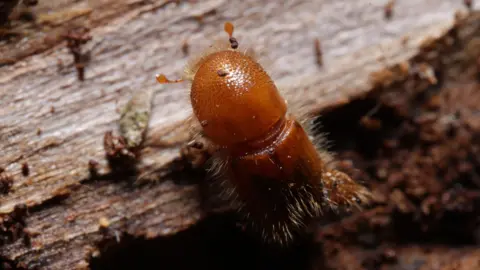 Sean Gallup/Getty Images
Sean Gallup/Getty ImagesIt is smaller than your fingernail, but this hairy beetle is one of the biggest single threats to the UK’s forests.
The bark beetle has been the scourge of Europe, killing millions of spruce trees, yet the government thought it could halt its spread to the UK by checking imported wood products at ports.
But this was not their entry route of choice – they were being carried on winds straight over the English Channel.
Now, UK government scientists have been fighting back, with an unusual arsenal including sniffer dogs, drones and nuclear waste models.
They claim the UK has eradicated the beetle from at risk areas in the east and south east. But climate change could make the job even harder in the future.
The spruce bark beetle, or Ips typographus, has been munching its way through the conifer trees of Europe for decades, leaving behind a trail of destruction.
The beetles rear and feed their young under the bark of spruce trees in complex webs of interweaving tunnels called galleries.
When trees are infested with a few thousand beetles they can cope, using resin to flush the beetles out.
But for a stressed tree its natural defences are reduced and the beetles start to multiply.
“Their populations can build to a point where they can overcome the tree defences – there are millions, billions of beetles,” explained Dr Max Blake, head of tree health at the UK government-funded Forestry Research.
“There are so many the tree cannot deal with them, particularly when it is dry, they don’t have the resin pressure to flush the galleries.”
Since the beetle took hold in Norway over a decade ago it has been able to wipe out 100 million cubic metres of spruce, according to Rothamsted Research.
‘Public enemy number one’
As Sitka spruce is the main tree used for timber in the UK, Dr Blake and his colleagues watched developments on continental Europe with some serious concern.
“We have 725,000 hectares of spruce alone, if this beetle was allowed to get hold of that, the destructive potential means a vast amount of that is at risk,” said Andrea Deol at Forestry Research. “We valued it – and it’s a partial valuation at £2.9bn per year in Great Britain.”
There are more than 1,400 pests and diseases on the government’s plant health risk register, but Ips has been labelled “public enemy number one”.
The number of those diseases has been accelerating, according to Nick Phillips at charity The Woodland Trust.
“Predominantly, the reason for that is global trade, we’re importing wood products, trees for planting, which does sometimes bring ‘hitchhikers’ in terms of pests and disease,” he said.
Forestry Research had been working with border control for years to check such products for Ips, but in 2018 made a shocking discovery in a wood in Kent.
“We found a breeding population that had been there for a few years,” explained Ms Deol.
“Later we started to pick up larger volumes of beetles in [our] traps which seemed to suggest they were arriving by other means. All of the research we have done now has indicated they are being blown over from the continent on the wind,” she added.
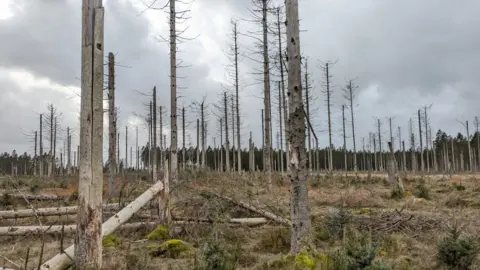 Daegan Inward/Forestry Research
Daegan Inward/Forestry ResearchThe team knew they had to act quickly and has been deploying a mixture of techniques that wouldn’t look out of place in a military operation.
Drones are sent up to survey hundreds of hectares of forest, looking for signs of infestation from the sky – as the beetle takes hold, the upper canopy of the tree cannot be fed nutrients and water, and begins to die off.
But next is the painstaking work of entomologists going on foot to inspect the trees themselves.
“They are looking for a needle in a haystack, sometimes looking for single beetles – to get hold of the pioneer species before they are allowed to establish,” Andrea Deol said.
In a single year her team have inspected 4,500 hectares of spruce on the public estate – just shy of 7,000 football pitches.
Such physically-demanding work is difficult to sustain and the team has been looking for some assistance from the natural and tech world alike.
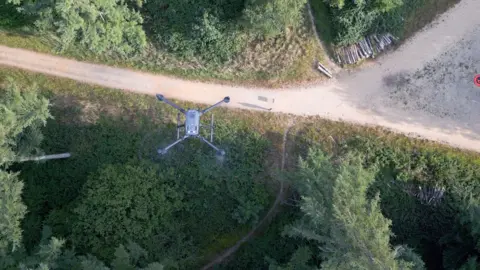 Tony Jolliffe/BBC
Tony Jolliffe/BBCWhen the pioneer Spruce bark beetles find a suitable host tree they release pheromones – chemical signals to attract fellow beetles and establish a colony.
But it is this strong smell, as well as the smell associated with their insect poo – frass – that makes them ideal to be found by sniffer dogs.
Early trials so far have been successful. The dogs are particularly useful for inspecting large timber stacks which can be difficult to inspect visually.
The team is also deploying cameras on their bug traps, which are now able to scan daily for the beetles and identify them in real time.
“We have [created] our own algorithm to identify the insects. We have taken about 20,000 images of Ips, other beetles and debris, which have been formally identified by entomologists, and fed it into the model,” said Dr Blake.
Some of the traps can be in difficult to access areas and previously had only been checked every week by entomologists working on the ground.
The result of this work means that the UK has been confirmed as the first country to have eradicated Ips Typographus in its controlled areas, deemed to be at risk from infestation, and which covers the south east and east England.
“What we are doing is having a positive impact and it is vital that we continue to maintain that effort, if we let our guard down we know we have got those incursion risks year on year,” said Ms Deol.
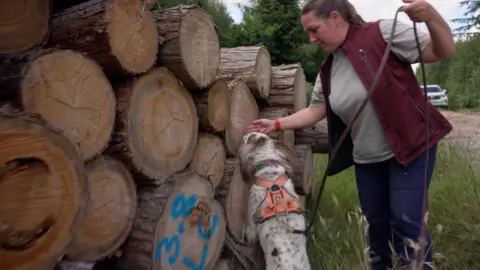 Tony Jolliffe/BBC
Tony Jolliffe/BBCAnd those risks are rising. Europe has seen populations of Ips increase as they take advantage of trees stressed by the changing climate.
Europe is experiencing more extreme rainfall in winter and milder temperatures meaning there is less freezing, leaving the trees in waterlogged conditions.
This coupled with drier summers leaves them stressed and susceptible to falling in stormy weather, and this is when Ips can take hold.
With larger populations in Europe the risk of Ips colonies being carried to the UK goes up.
The team at Forestry Research has been working hard to accurately predict when these incursions may occur.
“We have been doing modelling with colleagues at the University of Cambridge and the Met Office which have adapted a nuclear atmospheric dispersion model to Ips,” explained Dr Blake. “So, [the model] was originally used to look at nuclear fallout and where the winds take it, instead we are using the model to look at how far Ips goes.”
Nick Phillips at The Woodland Trust is strongly supportive of the government’s work but worries about the loss of ancient woodland – the oldest and most biologically-rich areas of forest.
Commercial spruce have long been planted next to such woods, and every time a tree hosting spruce beetle is found, it and neighbouring, sometimes ancient trees, have to be removed.
“We really want the government to maintain as much of the trees as they can, particularly the ones that aren’t affected, and then also when the trees are removed, supporting landowners to take steps to restore what’s there,” he said. “So that they’re given grants, for example, to be able to recover the woodland sites.”
The government has increased funding for woodlands in recent years but this has been focused on planting new trees.
“If we only have funding and support for the first few years of a tree’s life, but not for those woodlands that are 100 or century years old, then we’re not going to be able to deliver nature recovery and capture carbon,” he said.
Additional reporting Miho Tanaka

AI Research
AI replaces excuses for innovation, not jobs
AI isn’t here to replace jobs, it’s here to eliminate outdated practices and empower entrepreneurs to innovate faster and smarter than ever before.

AI Research
AI clamps down on fake science journals
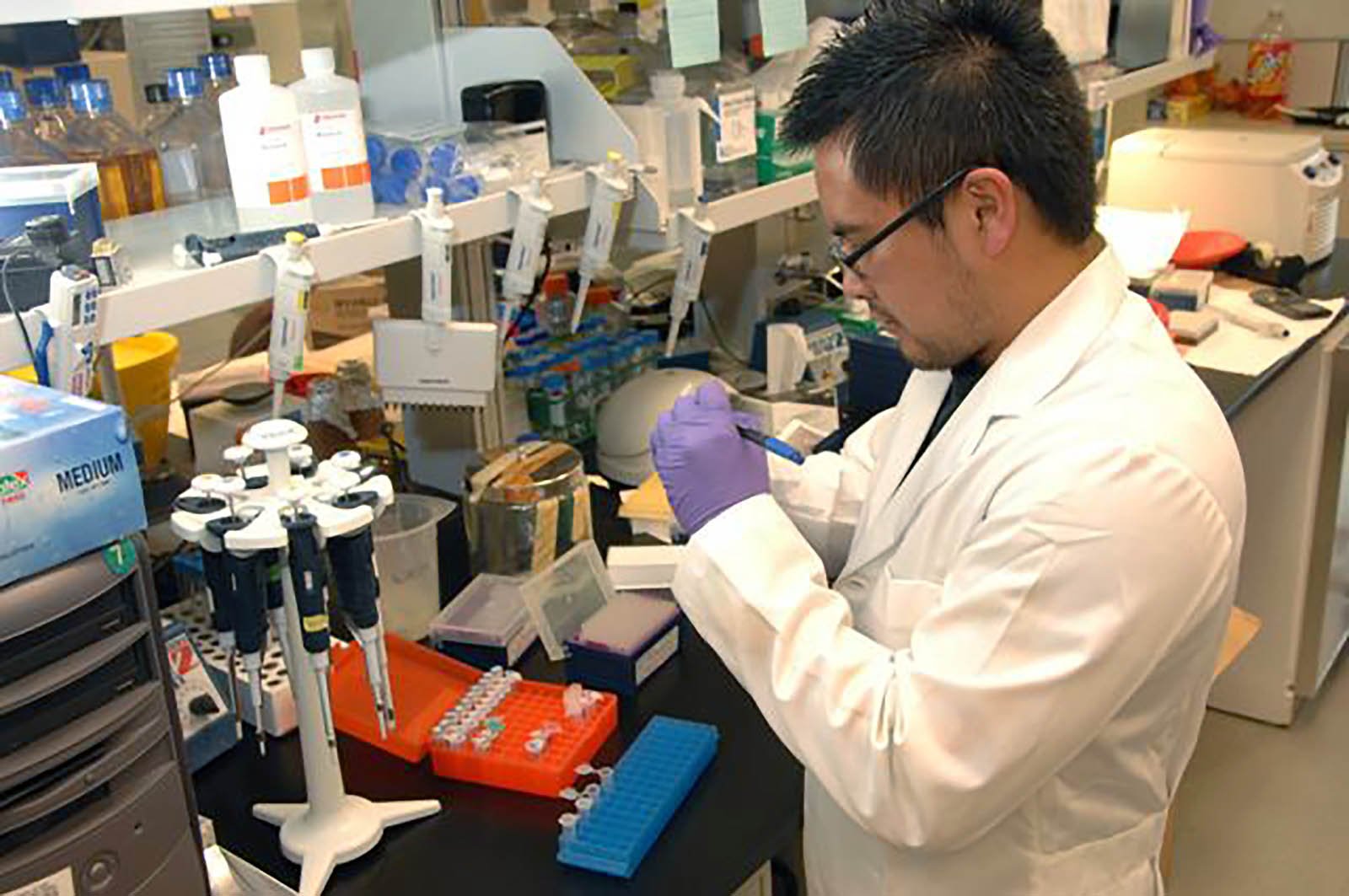
Medical Laboratory Scientist at bench with micropipettes. —
Courtesy U.S. National Institutes of Health (Public Domain)
By deploying a specially configured artificial intelligence, researchers at the University of Colorado Boulder have exposed ‘predatory’ scientific journals—those that trick scientists into paying for publication without proper peer review.
This was achieved by analyzing journal websites for AI-learned red flags like fake editorial boards, excessive self-citation, and sloppy errors. Through these pre-sets. the AI flagged over 1,400 suspicious titles out of 15,200 assessed.
The new AI tool automatically screens scientific journals, evaluating their websites and other online data for certain criteria: Do the journals have an editorial board featuring established researchers? Do their websites contain a lot of grammatical errors?
Many scientists, including this author, receive messages to our email inboxes. These spam messages come from people who purport to be editors at scientific journals, usually ones Acuña has never heard of, and offer to publish his papers — for a hefty fee.
The types of publications are sometimes referred to as “predatory” journals, since they target scientists, convincing them to pay hundreds or even thousands of dollars to publish their research without proper vetting.
Some organisations have long campaigned against such publications. For instance, the Directory of Open Access Journals (DOAJ). Since 2003, volunteers at the DOAJ have flagged thousands of journals as suspicious based on six criteria. (Reputable publications, for example, tend to include a detailed description of their peer review policies on their websites.)
Why does this matter?
In an era when prominent figures (notably Donald Trump) are questioning the legitimacy of science, stopping the spread of questionable publications has become more important than ever before.
Legitimate science
When scientists submit a new study to a reputable publication, that study usually undergoes a practice called peer review. In other words, outside experts read the study and evaluate it for quality.
AI model
The new AI system is not yet publicly accessible; however, the researchers hope to make it available to universities and publishing companies soon.
The application of the AI model appears in the journal Science Advances, titled “Estimating the predictability of questionable open-access journals.”
-
Tools & Platforms3 weeks ago
Building Trust in Military AI Starts with Opening the Black Box – War on the Rocks
-

 Ethics & Policy1 month ago
Ethics & Policy1 month agoSDAIA Supports Saudi Arabia’s Leadership in Shaping Global AI Ethics, Policy, and Research – وكالة الأنباء السعودية
-

 Events & Conferences3 months ago
Events & Conferences3 months agoJourney to 1000 models: Scaling Instagram’s recommendation system
-

 Jobs & Careers2 months ago
Jobs & Careers2 months agoMumbai-based Perplexity Alternative Has 60k+ Users Without Funding
-

 Business1 day ago
Business1 day agoThe Guardian view on Trump and the Fed: independence is no substitute for accountability | Editorial
-

 Funding & Business2 months ago
Funding & Business2 months agoKayak and Expedia race to build AI travel agents that turn social posts into itineraries
-

 Education2 months ago
Education2 months agoVEX Robotics launches AI-powered classroom robotics system
-

 Podcasts & Talks2 months ago
Podcasts & Talks2 months agoHappy 4th of July! 🎆 Made with Veo 3 in Gemini
-

 Podcasts & Talks2 months ago
Podcasts & Talks2 months agoOpenAI 🤝 @teamganassi
-

 Jobs & Careers2 months ago
Jobs & Careers2 months agoAstrophel Aerospace Raises ₹6.84 Crore to Build Reusable Launch Vehicle


